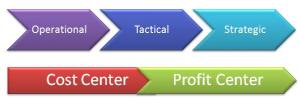 The short history of the training or education department within corporate organizations is an interesting mirror of the shift in economic paradigms from the Industrial Economy to the Knowledge Economy. These departments have moved from the operational level as cost centers to profit centers with their own “C” level leadership that in many cases reports directly to the CEO. It’s a glimpse into the future of where these “Departments of Learning” will be in the corporate hierarchy and how they will be perceived.
The short history of the training or education department within corporate organizations is an interesting mirror of the shift in economic paradigms from the Industrial Economy to the Knowledge Economy. These departments have moved from the operational level as cost centers to profit centers with their own “C” level leadership that in many cases reports directly to the CEO. It’s a glimpse into the future of where these “Departments of Learning” will be in the corporate hierarchy and how they will be perceived.
Let me back up a bit. The global economy has undergone three major and notable economic paradigms each with an attendant educational system. They can be summed up simple in the following list:
Agricultural Economy: We managed backs – we basically learned on-the-job.
Industrial Economy: We managed hands – we primarily learned in the formal classroom.
Knowledge Economy: We manage minds – we learn continuously in an ever-growing variety of ways.
Here’s a story that sums up the changes:
In 2007, I gave a presentation to the annual gathering of CIO’s at Boeing in Southern California. As the top CIO was leading me into the conference room, she told me that the building itself has an interesting history. Originally an orchard grove for oranges, the building was first used as a giant manufacturing facility for the production of airplanes. When the demand for planes was reduced, the building was cut up into floors, offices and cubicles and people spent their workdays in front of computers producing, refining, defining, revising, discussing, an communicating ideas. Ideas for new planes. Ideas for improving production of planes. Ideas about related projects that had something to do with planes. One piece of land, three economic paradigms.
The point is all they did all day was produce ideas, work with ideas, think about ideas, write and talk about ideas. There were still a small group of people who ultimately made those ideas into things – planes. But they were followed by the people who had more ideas about how to market it, sell it, teach people to fly it and so on and so on. So the Knowledge Economy is all about the mass production of ideas. Success in the Knowledge Economy is the ability to sift through all those ideas to come up with the ones that can be produced and sold. Turning ideas into money.
These workers are literally the corporate brain. In a flat digitally-interconnected world where 24×7 marketplaces are open to all and as a result are hypercompetitve, the Corporate IQ separates the winners from the losers, the successes from the failures. So making sure that all the employers can learn as much as they need to know and know-how to do, anytime and anyplace, become a strategic fact. Learning has become the most critical differentiator in this newest Knowledge Economy. And the “Department of Learning” is at the center of it all.
In a recent report by SABA Transforming Learning into a Strategic Business Enabler, the following facts emerged from interviews with over 612 leaders from the Director level and above:
- Overall 52.7% of respondents report that the learning function at their organization is seen as a strategic enabler for the business
- Only 13.7% report that the learning function at their organization is seen as a cost center.
With regard to the way these newly perceived strategic organizations are operating, here are some vital statistics:
- 4-6% more likely to deliver training to customers.
- 8-9% more likely to deliver training to partners/channels.
- 4-6% more likely to deliver training to suppliers.
- 25-42% more likely to report that training is aligned with business strategy.
- Twice as likely to use objective measures of employee performance to align their learning to the business strategy.
- Twice as likely to do formal learning requirements planning.
- Four times more likely to have a learning advisory board with members from the business and the learning function.
- 26-43% more likely to have an annual process of mapping the learning strategy to the business strategy for the year.
- 39% more likely to have been demonstrating the impact that training has on the core business.
The study goes into much greater depth if you’re interested in getting into the weeds. The point for me was that the training department in which I started only 30 years ago has moved from a cost center focusing on operational training that often was the first to be cut during a downsizing, rightsizing or capsizing, to being viewed as a critical strategic component to the core business. All those early discussions about ‘getting a seat at the table’ are finally being realized.